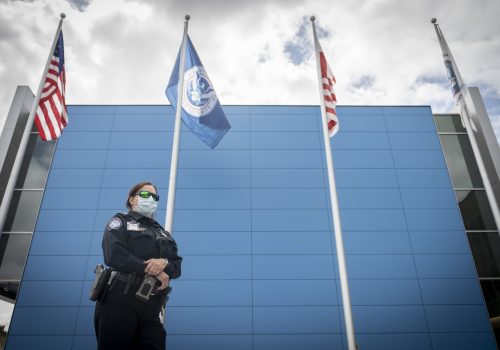Biometrics at the border: Balancing security, convenience, and civil liberties
FORWARD DEFENSE
ISSUE BRIEF RELEASE
Technological advances in biometrics—which include everything from fingerprints to facial recognition—hold the key to unlocking safer, more efficient US border operations.
In the aftermath of the tragic attacks of September 11, 2001, and following the creation of the Department of Homeland Security (DHS), inaugural Customs and Border Protection (CBP) commissioner Robert Bonner set the “twin goals” of border security and facilitation of lawful travel and trade. In this issue brief, Forward Defense nonresident senior fellow Seth Stodder and director of the Future of DHS Project Thomas Warrick argue that DHS must safely integrate biometrics into US border operations to reach these goals in an evolving security environment.
A new era of border security
For centuries, border agencies worldwide have leveraged biometric data to track the movement of people across geographies. Now, in alignment with clear mandates, governing bodies have access to advanced facial recognition capabilities that make cross-border travel more efficient, seamless, and secure. For example, US CBP’s Traveler Verification System (TVS) pilot program is already in place at ports, crossings, and transportation hubs across the United States—operationalizing comprehensive biometric entry and exit processes—and similar systems are being deployed around the world.
Government agencies and private industry are beginning to use [biometrics] to develop and deploy “smart borders,” to both increase security and process lawful trade and travel faster than before.
At the nexus of technology and human rights
Yet, despite the success demonstrated by the TVS pilot and similar programs, the Biden administration faces hesitation and distrust from Americans in expanding biometric data collection. Concerns include:
- Fear of a surveillance state – Autocratic states weaponize biometrics to achieve persistent surveillance, fueling valid calls for data-use safeguards. Congressional action must provide essential checks against this misuse of data and technology.
- Data protection standards – CBP must be capable of protecting against cyber hacks, an issue broadly applicable to federal government and resolved through strong governance, oversight, and cybersecurity funding.
- Accuracy and bias issues – Biometric algorithms must rate high in accuracy and low in bias, as CBP’s TVS pilot does. Nonetheless, transparency and continued supervision is vital.
These considerations can be managed with appropriate regulations, oversight, and funding.
Recommendations & next steps
CBP’s use of biometrics at the border is an essential tool in achieving the “twin goals” of security and facilitation. Recommended steps forward include the following:
- The Biden Administration should continue with CBP’s facial-biometric programs and move to finalize permanent expansion.
- CBP should continue improving facial recognition algorithms in coordination with the Transportation Security Administration’s Pre-Check program. CBP should continue its pilot version of Simplified Arrival for vehicle traffic at land borders.
- DHS should carefully consider and adopt most of the recommendations of the Homeland Security Advisor Council’s Biometrics Subcommittee. DHS should empower its Office of Strategy, Policy, and Plans to lead the development of DHS-wide policies on biometrics.
- DHS and CBP should expeditiously move to spend funds and expand biometrics capabilities at the borders. Congress should appropriate additional funds for operations of biometrics systems.
With strategic technological investment and deliberate safeguards, CBP can evolve to keep pace with growing traffic at US borders.
Generously sponsored by

About the authors
Watch the event
About the Future of DHS Project
Subscribe
Sign up for updates from Forward Defense to hear the latest on the trends, technologies, and military challenges shaping tomorrow.

Forward Defense, housed within the Scowcroft Center for Strategy and Security, generates ideas and connects stakeholders in the defense ecosystem to promote an enduring military advantage for the United States, its allies, and partners. Our work identifies the defense strategies, capabilities, and resources the United States needs to deter and, if necessary, prevail in future conflict.
Image: Photo: DHS Flickr



